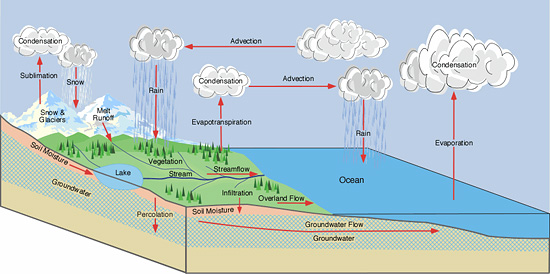The Pootatuck Watershed Association presents this documentary on saving our drinking water.
| Producer | Iroquois Gas Transmission System Candlewood Valley Trout Unlimited |
| Assistant Producer | Sean Corvino ALL HYPE Video Production |
| Director | Dan Holmes |
| Editor | Bill Cafarelli www.VideoArtWorks.com |
The Hydrologic Cycle

New England’s Drinking Water
- Drinking water is obtained by drilling wells into the region’s ground water or by pumping water from reservoirs or rivers.
- The public water system is regulated nationally by the Safe Drinking Water Act.
- When water falls to Earth in the form of rain, sleet, hail or snow, some of it runs off the surface of the ground and enters storm drains or nearby streams. Some of it falls into oceans, lakes, rivers and other water bodies, and some of it soaks into the ground. When water seeps into the ground, it moves downward due to gravity through the pore spaces found between soil particles and cracks in rock. Eventually, the water reaches a depth where the soil and rock are saturated with water. Water which is found in the saturated (or wet) part of the ground underneath the land surface is called, “ground water”.
- A rock or soil formation that is capable of yielding enough groundwater for human use is called an aquifer.
- Wells are drilled deep into the ground until they reach the groundwater far beneath the surface.
Information For Private Well Owners
- It is the homeowner’s responsibility to periodically test for water contamination.
- Human activities may cause well water contamination from industrial/commercial activities, improper waste disposal, road silting and oil spills, use of fertilizers and pesticides, fueling of lawn equipment and household wastes.
- Some contaminants are naturally occurring due to water making its way through the soil. The contaminants may include bacteria, radon, arsenic, uranium and other substances such as iron and magnesium.
- Studies show that there is contamination in some wells from methyl-tertiary-butyl ether (MtBE), radon and arsenic.
- Most contaminates can not be identified by taste or odor.
Steps to Protect your Well
- Make sure your well is capped or sealed.
- Periodically check the wellhead for cracking, corrosion etc.
- Slope the area around the well to drain surface runoff away from the wellhead.
- Do not cut the well casing below ground level.
- Avoid using chemicals near the well area.
- Regularly inspect your septic system as recommended.
Download the EPA’s Pocket Guide To Protecting Your Drinking Water.
How to Conserve Water
- Repair leaky faucets.
- Replace old household appliances like dishwashers and washing machines. Older equipment tends to not be as efficient and can leak.
- Only run your dishwasher when it is full.
- Compost food scraps and add compost to the soil in your yard.
- Take shorter showers.
- Turn water off while brushing teeth or shaving.
- Maximize natural and native vegetation outdoors.
- Don’t cut your lawn too short. Longer blades of grass give shade to the soil which improves moisture retention.